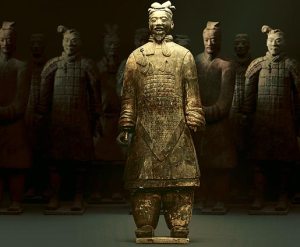Zhan Zhuang “Standing like a post” Standing Meditation
Standing builds structural integrity in your physique, calms the mind and emotions and it provides a foundation for internal qigong work known as “nei gong”.
As you are learning to connect with your internal energy, many new and intriguing adventures will open up to your awareness. In fact, awareness is the primary connection that you make as the path unfolds before you.
You can reach your health goals whatever they may be, whether they are physical health, as in posture, flexibility, balance or general strengthening or mental goals such as, improved memory, freedom from excessive thoughts or disordered thinking, or perhaps emotional goals like curing frustration, mania, anger, fear, grief, worry, depression or whatever else.
The one common denominator in almost all ailments is unbalanced energy within you. Even the most devastating illnesses often have their roots in basic problems with your personal energy and many are therefore preventable. Balancing our energies is the goal of all traditional Chinese medicine and Qigong is a basic part of TCM.
In the first two Qigong “lessons” here on this blog, I outlined the first skill you should master, Wuji. As the name implies Wuji is a starting point and it is where we begin all qigong exercises and the Taiji forms, yet there is a whole genre of “Wuji training” that can be explored.
Standing is sometimes called zhan zhuang, which means “standing like a post”, or referred to as standing meditation; it is in fact an excellent qigong exercise all by itself. There are no real ”forms“ per se, instead individual postures are sustained for a length of time as necessary.
The main goal here is to balance out our internal energy by standing still, however stilling your body often encourages thinking to arise; sometimes the thinking can become overwhelming. Redirect your thoughts into becoming aware of the 12 points outlined in the last lesson and only allow your thoughts to go through the “postural check list”.
Another technique to stop unnecessary thinking, is to simply count your breaths; paying attention to the air moving in and out as you do. When you find yourself caught up in a daydream, just start over with the alignment and then find your way back to your breathing; in this way you will learn to dissolve your mind and body together.
After we still our bodies, and refocus our thinking, errant energy tends to go into the emotions. This can be very annoying as thoughts and emotions are linked, often emotional thoughts like: “I feel dumb standing here”, “What are others thinking about me seeing me standing here?”, or “Am I wasting my time standing here?” Any excuse we can dream up to release us from learning about our true selves seems like a good enough reason to stop our training. Just go back through the same routine and you will find these emotions subside.
While standing in a posture, there are many other techniques that you may apply, such as various breathing practices and a whole host of higher-level skills known as “nei gong“. These skills will be explained in future articles about that topic but the first step into that whole universe of qigong arts starts with zhan zhuang.
To perform zhan zhuang all you need to do is stand, correctly of course, in any one of numerous postures. To avoid an emotional reason to give up, commit before hand to doing zhan zhuang for a certain length of time, say 10 or 15 minutes. You may stand in Wuji, or pick some postures from the Taiji form. In the beginning I recommend you attempt at least three minutes in each posture, that way you will not get bored so that during the 15 minutes you could manage five postures. Serious zhan zhuang practitioners may stand for up to an hour in one or two postures!
In coming lessons, I will show you some postures that can be used in addition to the ones you are learning as part of a Taiji class. Who knew that by just standing you could accomplish so much without knowing any forms?
Stand strong and you will develop good balance, strength, and energy.
Copyright Cory Williams 2010
More here: Qigong Lesson #4




Great write up! May I suggest you post it at each new intro course. I did not see it in your prior class and perhaps did not hear it during your classes the last month in quite the same way. I believe it would have been a great daily exercise for me this and intend to begin now. Thanks for doing this!
Thanks. This is rapidly becoming the main aspect of my practice, but so far I am just doing the basic Wuji posture. I wish I had started with this when I very first started Tai Chi, before I could even remember enough of the form to practice. Thank you, Cory.
Aloha Teacher Cory,
Thank you for sharing the set on medical Chi Gung on Friday, powerful. Would you please send me the link to the website of video.
Mahalo,
Cynthia
Pingback: Qigong Lesson #2 “Wuji” A Physical Reality « Taiji on Maui's Blog